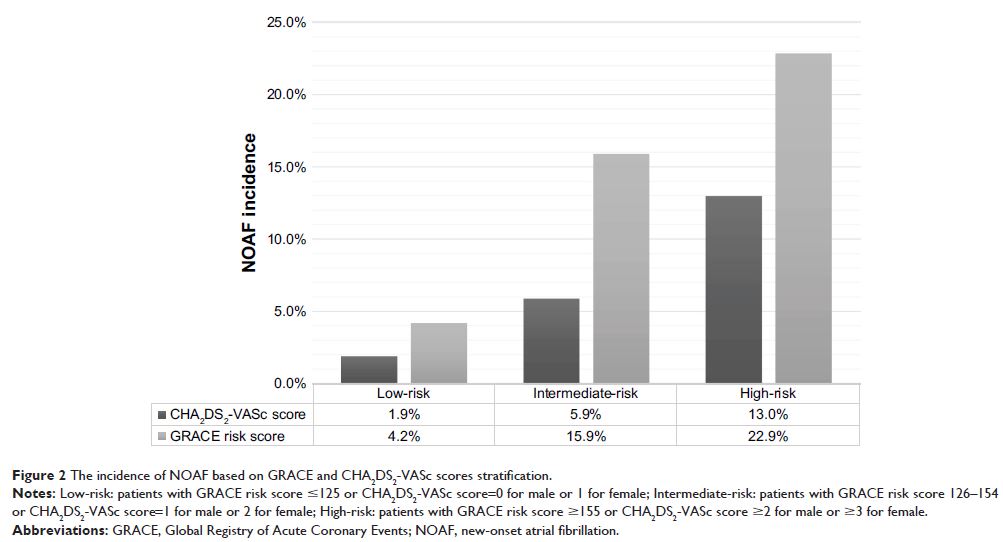108384
论文已发表
注册即可获取德孚的最新动态
IF 收录期刊
- 3.4 Breast Cancer (Dove Med Press)
- 3.2 Clin Epidemiol
- 2.6 Cancer Manag Res
- 2.9 Infect Drug Resist
- 3.7 Clin Interv Aging
- 5.1 Drug Des Dev Ther
- 3.1 Int J Chronic Obstr
- 6.6 Int J Nanomed
- 2.6 Int J Women's Health
- 2.9 Neuropsych Dis Treat
- 2.8 OncoTargets Ther
- 2.0 Patient Prefer Adher
- 2.2 Ther Clin Risk Manag
- 2.5 J Pain Res
- 3.0 Diabet Metab Synd Ob
- 3.2 Psychol Res Behav Ma
- 3.4 Nat Sci Sleep
- 1.8 Pharmgenomics Pers Med
- 2.0 Risk Manag Healthc Policy
- 4.1 J Inflamm Res
- 2.0 Int J Gen Med
- 3.4 J Hepatocell Carcinoma
- 3.0 J Asthma Allergy
- 2.2 Clin Cosmet Investig Dermatol
- 2.4 J Multidiscip Healthc

新发心房颤动并发 ST 段抬高型心肌梗死的风险评估:GRACE 和 CHA2DS2-VASc 评分之间的比较
Authors Luo JC, Dai LM, Li JM, Zhao JL, Li ZQ, Qin XM, Li HQ, Liu BX, Wei YD
Received 4 March 2018
Accepted for publication 20 April 2018
Published 6 June 2018 Volume 2018:13 Pages 1099—1109
DOI https://doi.org/10.2147/CIA.S166100
Checked for plagiarism Yes
Review by Single-blind
Peer reviewers approved by Dr Andrew Yee
Peer reviewer comments 2
Editor who approved publication: Dr Wu
Purpose: New-onset atrial fibrillation (NOAF) is a common finding in
patients with myocardial infarction (MI), but few studies are available
regarding the prediction model for its risk estimation. Although Global
Registry of Acute Coronary Events (GRACE) risk score (RS) has been recognized
as an effective tool for the risk evaluation of clinical outcomes in patients
with MI, its usefulness in the prediction of post-MI NOAF remains unclear. In
this study, we sought to validate the discrimination performance of GRACE RS in
the prediction of post-MI NOAF and to make a comparison with that of the CHA2DS2-VASc score in patients
with ST-segment elevation myocardial infarction (STEMI).
Patients and
methods: A total of 488 patients with STEMI
who were admitted to our hospital between May 2015 and October 2016 without a
history of atrial fibrillation were retrospectively evaluated in this study.
GRACE and CHA2DS2-VASc scores were calculated for each patient. Patients were divided
into low (GRACE RS≤125)-, intermediate (GRACE RS 126–154)-, and high (GRACE
RS≥155)-risk groups. Receiver operating characteristic curve analyses were
performed to evaluate the discrimination performance of both RSs. Model
calibration was evaluated by using Hosmer–Lemeshow goodness-of-fit test (HLS).
Results: Of the 488 eligible patients, 49 (10.0%) developed NOAF during
hospitalization. In the overall cohort, the discrimination performance of GRACE
RS (C-statistic: 0.76, 95% CI: 0.72–0.80) was significantly better than that of
CHA2DS2-VASc score (C-statistic: 0.68, 95% CI: 0.64–0.72; comparison p =0.03). For subgroup analysis,
GRACE RS tended to be better than the CHA2DS2-VASc score in all but
the intermediate-risk group as evidenced by C-statistics of 0.60 and 0.65 for
GRACE and CHA2DS2-VASc scores, respectively. Excellent calibration was achieved except
for GRACE RS in females (HLS p =0.05).
Conclusion: The diagnostic performance of GRACE RS is relatively high as well
as better than that of the CHA2DS2-VASc score with
respect to the prediction of post-MI NOAF.
Keywords: myocardial infarction, atrial fibrillation, GRACE risk score, CHA2DS2-VASc score, risk
prediction
